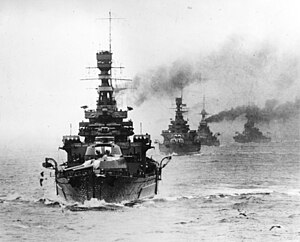Singapore strategy
| Singapore strategy | |
|---|---|

HMS Repulse leads her sister ship HMS Renown and other Royal Navy capital ships during manoeuvres in the 1920s
|
|
| Era | 1919–1942 |
| Battlespace | Sea |
The Singapore strategy was a naval defence policy of the British Empire that evolved in a series of war plans from 1919 to 1941. It aimed to deter aggression by the Empire of Japan by providing for a base for a fleet of the Royal Navy in the Far East, able to intercept and defeat a Japanese force heading south towards India or Australia. To be effective it required a well-equipped base; Singapore, at the eastern end of the Strait of Malacca, was chosen in 1919 as the location of this base; work continued on this naval base and its defences over the next two decades.
The planners envisaged that a war with Japan would have three phases: while the garrison of Singapore defended the fortress, the fleet would make its way from home waters to Singapore, sally to relieve or recapture Hong Kong, and blockade the Japanese home islands to force Japan to accept terms. The idea of invading Japan was rejected as impractical, but British planners did not expect that the Japanese would willingly fight a decisive naval battle against the odds. Aware of the impact of a blockade on an island nation at the heart of a maritime empire, they felt that economic pressure would suffice.
The Singapore strategy was the cornerstone of British Imperial defence policy in the Far East during the 1920s and 1930s. By 1937, according to Captain Stephen Roskill, "the concept of the 'Main Fleet to Singapore' had, perhaps through constant repetition, assumed something of the inviolability of Holy Writ". A combination of financial, political and practical difficulties ensured that it could not be successfully implemented. During the 1930s, the strategy came under sustained criticism in Britain and abroad, particularly in Australia, where the Singapore strategy was used as an excuse for parsimonious defence policies. The strategy ultimately led to the despatch of Force Z to Singapore and the sinking of the Prince of Wales and Repulse by Japanese air attack on 10 December 1941. The subsequent ignominious fall of Singapore was described by Winston Churchill as "the worst disaster and largest capitulation in British history".
...
Wikipedia
